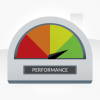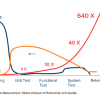People & Teams
Articles
|
|
Responsibly Reporting Performance Test Results: Trends, Noise, and Uncertainty In order for performance test results to have value, you should report them in context. There are two main considerations: How do these compare to previous results? And how can we provide early reports on performance while emphasizing that these are preliminary results that may change significantly as we progress? Here are some ideas for responsible reporting. |
|
 |
7 Simple Tips for Better Performance Engineering Rigorous practices to reinforce performance and resilience, and testing continuously for these aspects, are great ways to catch a problem before it starts. And as with many aspects of testing, the quality of the performance practice is much more important than the quantity of tests being executed. Here are seven simple tips to drive an efficient performance and resilience engineering practice. |
|
 |
The Shift-Left Approach to Software Testing The earlier you find out about problems in your code, the less impact they have and the less it costs to remediate them. Therefore, it's helpful to move testing activities earlier in the software development lifecycle—shifting it left in the process timeline. This article explores the shift-left methodology and how you can approach shifting left in your organization. |
|
 |
Mob Programming for Low-Code and No-Code Development In low-code and no-code development, as the names suggest, developers do less actual coding—they create applications through GUIs and configuration instead of traditional programming. But mob programming is still a useful practice, because the entire team can clarify requirements, discuss development and test strategies, and implement the best ideas. Everyone gets to learn and contribute. |
|
|
|
3 Methods for Better Communication and More Effective Testing Successful delivery of software requires the entire team, so it’s imperative that everyone choose their words carefully so they convey what they really mean, are sensitive to others’ feelings, and consider all aspects of a problem. Here are three questions to remember when communicating about your software testing projects to ensure you’re considering the power of words. |
|
 |
Test Faster: How We Cut Our Test Cycle Time in Half In just a year, one test team reduced its test cycle by more than 50 percent. It took analysis, planning, and effort—first they looked into how they spent their time, and then they questioned whether they could reduce time in any of those areas. Once they knew where they could be more efficient, they could start tackling their blockers. Here's how you can, too. |
|
|
|
Examining Cross-functionality Bias on Software Development Teams Cross-functionality means having all the necessary people and skills on one self-organizing team. Unfortunately, the execution of cross-functionality is often biased. The main traps we fall into are misunderstanding the value of specialization, hero worship, and not “walking the cross-functional talk” as organizations. Let’s examine each of these pitfalls in the hope that your teams may avoid them. |
|
 |
Getting Your New Web Test Automation Up and Running So you have the responsibility of a new team and getting an entirely new web automation test infrastructure up and running. Here are the hurdles, pitfalls, and successes one QA director encountered, along with the milestones the team defined to measure success, how they migrated their existing manual tests, and the path they took to establish the new web test automation initiative. |
|
 |
7 Ways Monitoring Can Help You Be a Better Tester Monitoring makes your testing work easier, helps you manage certain biases you may have, and lets you learn a lot about the product, users, and even your own processes. Here are seven concrete benefits testers get from monitored data that you can use to convince your team to implement monitoring—as well as realize for yourself. |
|
 |
Reporting Automated Test Results Effectively The modern iterative software development lifecycle has developers checking in code to version control systems frequently, with continuous integration handling building and running automated tests at an almost equally fast rate. This can generate an enormous amount of test data. Here’s how you can ensure you are reporting results effectively across your team and realizing all the benefits of that information. |












